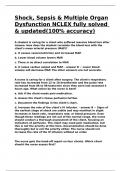Exam (elaborations)
Shock, Sepsis & Multiple Organ Dysfunction NCLEX fully solved & updated(100% accuracy)
- Course
- Institution
A student is caring for a client who suffered massive blood loss after trauma. How does the student correlate the blood loss with the client's mean arterial pressure (MAP)? a. It causes vasoconstriction and increased MAP. b. Lower blood volume lowers MAP. c. There is no direct correlation to MAP...
[Show more]



